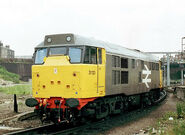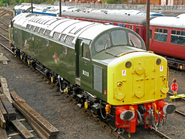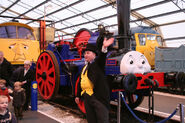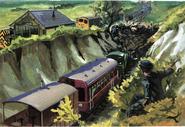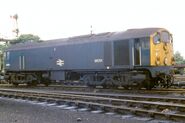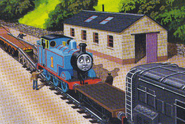No edit summary |
|||
| Line 243: | Line 243: | ||
'''This diesel''' appeared in the third illustration of [[Thomas and the Great Railway Show#Not the Ticket|Not the Ticket]], pushing Thomas onto a lorry when he was being taken to the [[National Railway Museum]] in York. |
'''This diesel''' appeared in the third illustration of [[Thomas and the Great Railway Show#Not the Ticket|Not the Ticket]], pushing Thomas onto a lorry when he was being taken to the [[National Railway Museum]] in York. |
||
| − | The diesel |
+ | The diesel is based on a BR Class 08 and painted black which is almost similar to Diesel. Over seventy members of this class survive today in preservation, while around 100 remain in service on the national rail network. They were in fact the most successful shunting engines in the world, with 996 of them built. |
Revision as of 23:23, 24 June 2018
In the Railway Series, several diesels from British Railways have appeared.
Stepney the "Bluebell" Engine
- “Stepney's a match for any diesel, besides his controller will take care of him."
"He's a brae engine fur aw 'at! Fancy fightin' his way ben aw those Diesels just tae see us!” - ― Percy and Douglas
These diesels appeared in the fourth illustration of Bluebells of England looking at Stepney.
D701
The first diesel is painted green and cream and had a yellow face. It is based on a BR Class 31 Brush Type 2. 31120 is another member of this class. This diesel's number is D701 and its head code is "4F12".
Diesel 40125
The second diesel is painted maroon and is based on a BR Class 52 "Western". All diesels of this class were given two-word names, the first word being "Western" and thus the type became known as Westerns.
The Last Diesel
The last diesel is painted dark green all over and is based on a BR Class 40. The Diesel and Old Stuck-Up are also members of this class. This diesel's number is D782.
Trivia
The first diesel
- Over two-hundred-sixty-three of this class was built from 1957 and 1962, twenty-six of these diesel engines survived into preservation.
- Ten more of these engines were in preservation but were scrapped from either accidents or to give spare parts to other engines.
- These diesels were given two nicknames, first being "Toffee Apples" because of the shape of their control lever and the second "Skinheads" because the first few engines didn't have the codebox on the front of the roof.
- The number it carries is completely fictional, None of Class 31's wore this number.
The second diesel
- Over seventy-four was built between 1961 and 1964, seven of these diesel engines have survived into preservation.
- These engines where given the nickname "Westerns" because they commonly worked on the Western region of British Railways.
The last diesel
- Over two-hundred of this class was built from 1958 to 1962. Seven have been preserved.
- These engines were given the nickname "Whistlers" because of the strange whistling noise their engines made.
- The number it carries is completely fictional, none of class 40's wore this number.
Gallery
Enterprising Engines
- “We stayed there for days, with Diesels baying and growling like hounds. I was very frightened!”
- ― Oliver
These diesels appeared in Escape three were alongside a signal box near an old quarry branch where Oliver, Isabel and Toad briefly hid to escape scrap, and another one was at Barrow-in-Furness.
Class 08
The first diesel was painted with yellow and black "hazard" stripes and appeared to be based on a Class 08. Unlike most Class 08 featured in the Railway Series and the Television series, his/her face appeared to be descending from his/her cab, rather than his/her front end.
D5701
The second diesel was painted in British Railways' "Rail Blue" livery with large yellow warning panels, and appeared to be based on a BR Class 28. BoCo and D5705 are also members of this class. He/she appears to be D5701, since that engine was the only Class 28 to be painted in "Rail Blue" during the class' existence.
The Third Diesel
Upon closer inspection of the main line going away from the signal box, a third diesel engine can be seen in the background. Its class is unknown.
The Fourth Diesel
- “Yoohoo! Yoohoo! A steamer's escaping! Yoohoo!”
- ― The fourth diesel
The fourth diesel was from Barrow-in-Furness. It shouted a warning that Oliver was escaping. When Douglas was helping Oliver, Isabel and Toad escape from scrap, he/she witnessed the event. Douglas told the stowaways to take no notice of the diesel. This diesel was not seen in any illustrations, making it unknown what his/her basis was.
Trivia
- Their roles in the television series were briefly replaced by Diesel, BoCo, and Mavis.
Gallery
James and the Diesel Engines
- “Visiting diesels sometimes boasted about how special they were. Usually, BoCo and Bear had to spend the next day smoothing ruffled feelings.”
- ― The Author, Old Stuck-Up

Old Stuck-Up, a visiting diesel.
Several diesels from the Other Railway have visited the Island of Sodor on several different occasions. Visiting diesels are known to be particularly haughty, as they feel superior to steam engines and often put the steam engines down.
They aren't well documented or known. However, known visiting diesels include Diesel, The Diesel, D199 and Old Stuck-Up.
Thomas and the Great Railway Show
| ||||
|---|---|---|---|---|
This diesel appeared in the third illustration of Not the Ticket, pushing Thomas onto a lorry when he was being taken to the National Railway Museum in York.
The diesel is based on a BR Class 08 and painted black which is almost similar to Diesel. Over seventy members of this class survive today in preservation, while around 100 remain in service on the national rail network. They were in fact the most successful shunting engines in the world, with 996 of them built.


